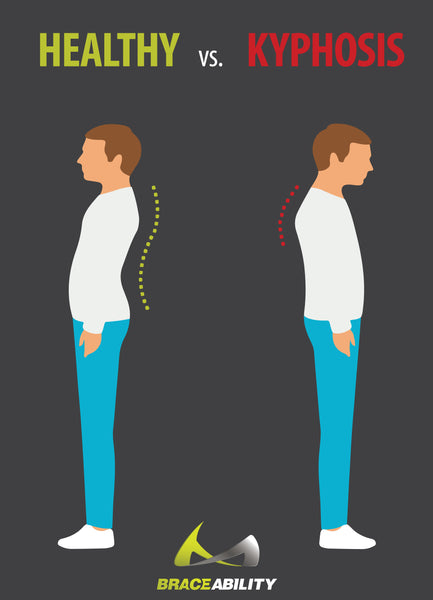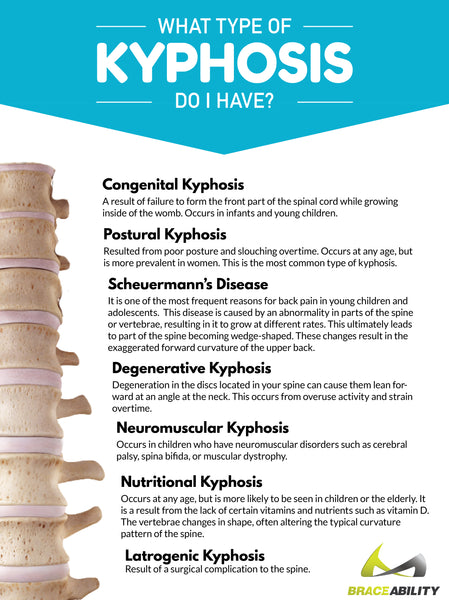There are many different treatment options available for Kyphosis. These different treatments depend on a multitude of factors including age, the severity of your condition, and causation of your condition.
What Exactly is Kyphosis?

Kyphosis is a spinal disorder that causes your upper thoracic back region to curve forward. This condition makes you look like you’re hunching or slouching over. As you may notice if you look at someone’s spine or back, they have a natural curve. For a healthy spine, that natural curve should be at an angle around 20-45 degrees. Those who have kyphosis, however, their abnormal curvature in their spine sits at an angle of over 50 degrees.
How is Kyphosis Diagnosed?
-
Exercises
-
X-Rays
-
CT Scan
-
MRI Scan
-
Blood Tests
Along with many other medical conditions, early detection is a key
If you believe you have a form or type of kyphosis, be proactive and speak with your doctor. There are many different ways doctors will help diagnose your problem. Especially in adolescents and infants, treating kyphosis at an early stage can help prevent the curve progression of future spine problems. Aside from adolescents, early detection can be possible in adults as well.
Your doctor may ask you to do several exercises to see if your balance and range of motion is affected. In addition, they can decipher from a postural problem or a structural problem by having you lie down on your back, analyzing your curve.
Another way doctors can finalize your diagnosis and the causation of your condition is by doing X-rays. In severe cases, a CT scan can help build a 3D image of your spine. An MRI scan can also be used to produce images inside your spine.
In adults, blood tests are used as an additional way to check for other infections in the spine.
Different Types of Kyphosis
After you have been diagnosed with kyphosis, it is likely your doctor will inform you of the type of your condition. While kyphosis looks similar in most individuals on the outside, there are different forms or types that are the underlying factors.
The types are classified into two general categories, postural and structural. Postural is caused by slouching or poor posture in your back whereas structural is caused by birth defects or from another spinal problem.

How Can I Treat Each Different Type?
-
Congenital kyphosis
Usually, early surgery procedures help to reduce future curve progression and are the best option in most cases. During the surgery, the surgeon will place the spine in a more natural position by using rods and implants to help support the spine.
-
Postural kyphosis
This specific condition can be treated by a number of things. Exercises such as yoga poses, chest stretches, and weighted exercises can help strengthen your back, neck, and spine muscles. Physical therapy is also a tool used to help treat postural kyphosis. Finally, a posture brace specifically for posture correcting can not only help ease your kyphosis pain but when used early, can help prevent it.
Here at BraceAbility, we have a wide selection of posture correcting braces that are adjustable and customizable specifically for you. Whether you need more support by using our postural extension back brace or our lightweight posture corrector, you will see a major improvement in your posture.
-
Scheuermann’s Disease
Since this type occurs in children while they are growing, a back brace is usually used to help stop the curve from bending more. Depending on the severity of your child’s case or at the beginning stages, it is recommended to wear this brace for almost all of their day. Another treatment option for this disease is different strengthening exercises and physical therapy.
For severe cases, surgery is used to help treat individuals with an abnormal curve of over 75 degrees or if they have extreme pain.
-
Degenerative kyphosis
If you are experiencing pain, initially start with conservative treatments such as physical therapy, chiropractor visit, anti-inflammatory medicines, and strengthening of the core and back muscles. If this pain persists, surgery may be an option.
-
Neuromuscular kyphosis
Based on the individual, surgery or a back brace support may be an option.
-
Nutritional kyphosis
Talk to your physician or nutritionist for a plan to help get a surplus of those key ingredients you’ve been missing. Physical therapy and exercise will also help along with a back support brace for extra stabilization. For this type, it is extremely important to be proactive and try to maintain a healthy lifestyle.
-
Iatrogenic kyphosis
Depending on severity, another surgery may be required to help fix the complication.












